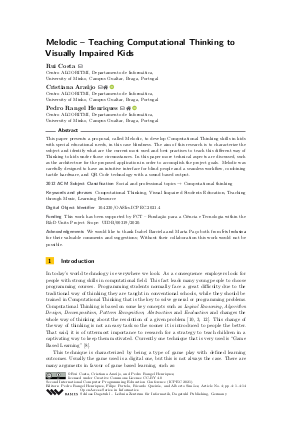OASIcs.ICPEC.2021.4.pdf
- Filesize: 1.51 MB
- 14 pages

 Creative Commons Attribution 4.0 International license
Creative Commons Attribution 4.0 International license

This paper presents a proposal, called Melodic, to develop Computational Thinking skills in kids with special educational needs, in this case blindness. The aim of this research is to characterize the subject and identify what are the current most used and best practises to teach this different way of Thinking to kids under those circumstances. In this paper more technical aspects are discussed, such as the architecture for the proposed application in order to accomplish the project goals. Melodic was carefully designed to have an intuitive interface for blind people and a seamless workflow, combining tactile hardware, and QR Code technology with a sound based output.


Feedback for Dagstuhl Publishing